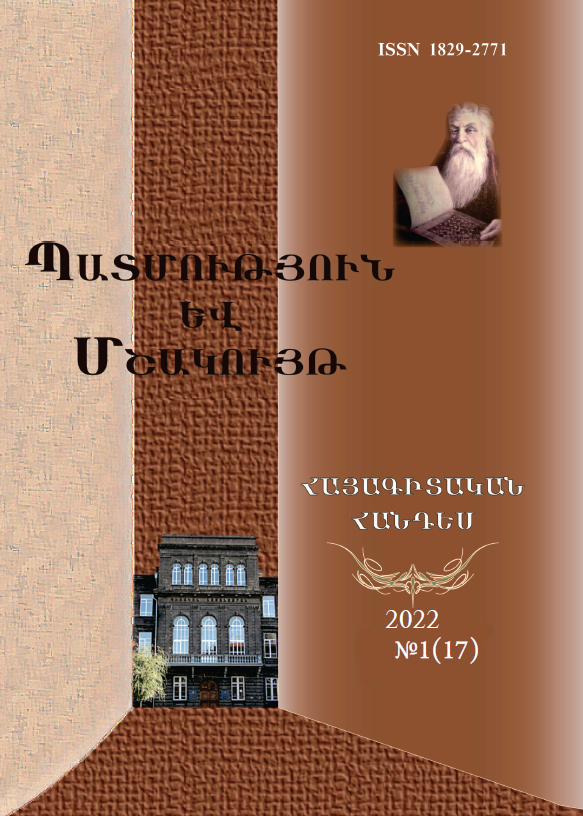Silver Belt Collection from the Treasury Museum of Mother See of Holy Etchmiadzin
DOI:
https://doi.org/10.46991/hc.2022.17.1.232Keywords:
Treasures of Etchmiadzin, Jewelry of Etchmiadzin, silver jewelry, silver belts, silversmiths, silversmith schools, history of silversmithingAbstract
In the XIX-XX centuries, belt was an important part of the Armenian folk costume. Silver belts were created in different areas of Western and Eastern Armenia. They varied from one another by the form of clasps, decoration, and often in creation techniques.
The silver collection of the Treasury of Mother See of Holy Etchmiadzin is unique in terms of its richness and variety. The purpose of this article is to study the silver belts of the Treasury that have not been examined before.
Among the women's belts of the Treasury, there is one with a butterfly-ribbon clasp (199), which repeats the structure of Vaspurakan belts, but the decoration of it seems to be pretty similar to another one that was created in Kars.
From the men's belts collection, it is worth mentioning the one decorated with the image of a kinto (258) that has the surname of the master preserved - "М АИРАПETOBЪ". During our research, we had found five belts created by the same silversmith in different museums in Armenia. In fact, so far this is the largest collection known to us being created by the same master and consisting of diverse types of belts. In our opinion, this silversmith is Mkrtich Nikoghos Ayrapetov, who worked in the Armenian market of Tbilisi (Georgia) during 1893-1914.
One of the men's belts in the Treasury is decorated with a depiction of a crown. During the research, we found several other belts with such decoration. Probably such "Crown Belts" were created for high-ranking people by special order.
Each of the belts of the Treasury collection has unique difference/s from similar ones kept in other museums, which testifies to the skill and mastery of our silversmiths.
References
Ավագյան Ն․ Հայկական գոտիները 19-րդ դարում և 20-րդ դարի սկզբին// «Բանբեր Երևանի համալսարանի», 1987, 1 (61), Երևան:
Զարդերի հավաքածու, Երևան քաղաքի պատմության թանգարան, Երևան, 2008:
Թօքաթ Յովսեփ (2005), Հայ արծաթագործ վարպետներ, Լոս Անջելես:
Ղազարյան Մ., Էջմիածնի հարստությունները //«Էջմիածին» Պաշտօնական ամսագիր Հայրապետական Աթոռոյ Ս. Էջմիածնի. Էջմիածին, Ս. Էջմիածին, 1987, hտ. Ե-Զ, էջ 92-101:
«Լուսիկ Ագուլեցու Անցյալի մասունքներ հավաքածուն» (2010), Երևան: «Տիգրան Մեծ»:
Մարգարյան Հ․(1988), Հայկական արծաթե գոտին․ Հայաստանի ազգագրություն պետական թանգարանի հավաքածուում 19-րդ դարի վերջի և 20-րդ դարի սկզբի հայկական արծաթե գոտիների հավաքածուն, «Կուլտուր-լուսավորական աշխատանք», թ 7-8:
Չուգասզյան Լ․ (2010), Ոսկերչությունը Հայաստանում, «Լուսիկ Ագուլեցու Անցյալի մասունքներ հավաքածուն», Երևան, «Տիգրան Մեծ»:
Պատրիկ Ա․ (1967), Հայկական տարազ. Հնագույն ժամանակներից մինչև մեր օրերը, Երևան։
Պողոսյան Ա․, Բալայան Մ․ (2020), Արցախի պատմաերկրագիտական թանգարանի արծաթյա զարդերի հավաքածուն։
Պողոսյան Ս. (2010), Արծաթե գոտիներ, ԱՊԹ-ի արծաթե գոտիների հավաքածուն, «Լուսիկ Ագուլեցու Անցյալի մասունքներ հավաքածուն», Երևան, «Տիգրան Մեծ»։
Տեր-Ղևոնդյան Հ., Արծնագործութիւնը եւ սեւկիտուածագործութիւնը Հայաստանի մէջ // «Բազմավեպ», 1986, թ․ 1-4։
Տեր-Ղևոնդյան Հ․, Հայկական արծաթագործական աշխարհիկ զարդերը // «Լրաբեր հասարակական գիտությունների», 1965, հ․ 11, Երևան։
Аствацатурян Э. (1982), Указатель клейм и имён Кавказских мастеров оружейного и серебряного дела. Москва.
Аствацатурян Э. (1978), Мастера серебряного дела Закавказья в XIX-начале XX в, ч. I. Москва.
REFERENCES
Avagyan N․ Haykakan gotinjerě 19-rd darum ew 20-rd dari skzbin// «Banbjer JErewani hamalsarani», 1987, 1 (61), Erewan:
Zardjeri havak‘atsu, Erewan k‘aghak‘i patmut‘yan t‘angaran, Erewan, 2008:
T‘ōk‘at‘ Hovsjep‘ (2005), Hay ardzat‘akordz varpjetnjer, Los Anjjeljes:
Ghazaryan M., Ejmiadzni harstut‘yunnjerě //«Ejmiatsin» Pashtōnakan amsagir Hayrapjetakan At‘oroy S. JEjmiatsni. JEjmiatsin, S. JEjmiatsin, 1987, ht. JE-Z, ēj 92-101:
«Lusik Aguljets‘u Ants‘yali masunk‘njer havak‘atsun» (2010), Erewan: «Tigran Mjets»:
Margaryan H․(1988), Haykakan artsat‘je gotin․ Hayastani azgagrut‘yun pjetakan t‘angarani havak‘atsuum 19-rd dari vjerji ew 20-rd dari skzbi haykakan artsat‘je gotinjeri havak‘atsun, «Kultur-lusavorakan ashkhatank‘», t‘ 7-8:
CH‘ugaszyan L․ (2010), Oskjerch‘ut‘yuně Hayastanum, «Lusik Aguljets‘u Ants‘yali masunk‘njer havak‘atsun», JErewan, «Tigran Mjets»:
Patrik A․ (1967), Haykakan taraz. Hnaguyn zh’amanaknjerits‘ minch‘ew mjer ōrjerě, Erewan։
Poghosyan A․, Balayan M․ (2020), Arts‘akhi patmajerkragitakan t‘angarani artsat‘ya zardjeri havak‘atsun։
Poghosyan S. (2010), Artsat‘je gotinjer, APT‘-i artsat‘je gotinjeri havak‘atsun, «Lusik Aguljets‘u Ants‘yali masunk‘njer havak‘atsun», Erewan, «Tigran Mjets»։
Tjer-Ghewondyan H., Artsnagortsut‘iwně yw sywkituatsagortsut‘iwně Hayastani mēj // «Pazmavjep», 1986, t‘․ 1-4։
Tjer-Ghewondyan H․, Haykakan artsat‘agortsakan ashkharhik zardjerě // «Lrabjer hasarakakan gitut‘yunnjeri», 1965, h․ 11, Erewan։
Aсtvacatuрjan E. (1982), Ukazatjel’ kljeйm i imjon Kavkazсkix maсtjeрov oрuzhjeйnogo i сjeрjebрjanogo djela. Moсkva.
Aсtvacatuрjan E. (1978), Maсtjeрa сjeрjebрjanogo djela Zakavkaz’ja v XIX-nachalje XX v, ch. I. Moсkva.
Downloads
Published
Issue
Section
License
Copyright (c) 2022 Satenik Chookaszian

This work is licensed under a Creative Commons Attribution-NonCommercial-ShareAlike 4.0 International License.

